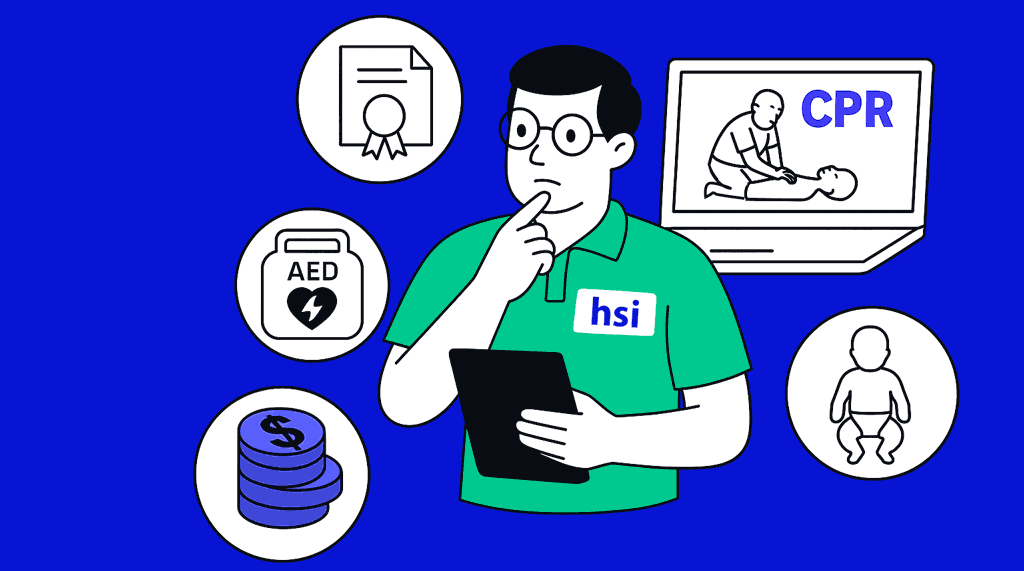How much $$$ does it cost to become a CPR instructor and what is my $$$ potential?

So, you’re thinking about becoming a CPR instructor? It’s a pretty amazing gig—helping people save lives while making some extra cash on the side (or even turning it into your full-time hustle!). But before you jump in, let’s break down the costs you’ll need to budget for, from start to finish.
Step 1: Get Certified First!
Before you can teach, you need to be CPR-certified yourself. It’s like passing your driving test before becoming the instructor. Most people will need Basic Life Support (BLS) certification if you’re teaching healthcare providers or Heartsaver CPR for general folks. The price? Usually somewhere between $75 to $150, depending on where you take it. It’s a small price to pay for a life-saving skill, right?
Step 2: Instructor Training – The Big Step
Now it’s time to step up and become an instructor. This is where the majority of your initial investment comes in. CPR instructor courses range from $500 to $935. Here’s what you’re paying for:
- Instructor Essentials Course: A must-have. This is an online course, usually around $35.
- Hands-On Training: Your in-person session, which costs anywhere from $250 to $600, depending on where you’re located.
- Monitoring: Some centers might charge a fee to monitor your first class. It’s anywhere from $0 to $150, but sometimes it’s included in your initial course fee.
It may seem like a lot upfront, but trust me—once you’re teaching, you’ll earn it back in no time.
Step 3: Equipment Costs – What You’ll Need to Start Teaching
Alright, here’s the part no one talks about upfront—equipment costs. To teach a class, you’ll need some gear. Don’t worry, it’s a one-time investment, and you can use it over and over (just like your Netflix password—no judgment).
Here’s a quick breakdown of what you’ll need:
- Manikins: These are essential. A good quality manikin can run between $100 to $1,200. You’ll likely want to start with a few to accommodate different class sizes.
- AED Trainers: These devices simulate real AEDs (the defibrillators). Expect to spend $100 to $500 on one, depending on the model.
- Masks & Barriers: Some training centers might provide these, but having your own sets is handy. Budget about $50 to $100.
All in all, your initial equipment outlay could range from $500 to $2,000, depending on the quality and quantity of the gear you buy. Remember, it’s a long-term investment. 🛠️
Step 4: Ongoing Costs – Don’t Forget the Extras
Don’t forget, every student will need certification cards after they complete their course. Depending on whether you’re aligned with AHA, Red Cross, or HSI, these cards will cost between $10 and $30 per student. If you’re training large groups, this adds up. But here’s the good news: you’ll factor this into your class fee.
Step 5: So, What Can You Earn? 💵
Here’s the fun part—making that money. The amount you can charge varies depending on your location, the type of course, and whether you’re working independently or through a training center. But let’s break it down:
- Basic CPR Class: You can charge between $50 and $100 per student. If you’ve got a class of 10 students, that’s $500 to $1,000 for just a few hours of work.
- Advanced Courses (BLS, ACLS, PALS): If you’re teaching healthcare providers, you can charge even more—$100 to $250 per student. Let’s say you teach a class of 10 ACLS students at $200 each. That’s $2,000 in one day!
Once you’ve paid off your initial investment, it’s almost all profit. And don’t forget—CPR is a skill that needs to be renewed every couple of years, so you’ll likely have repeat customers.
Is It Worth It?
Absolutely! Not only can you make back your initial investment after just a few classes, but you’ll also have the satisfaction of knowing you’re teaching a life-saving skill. Whether you’re looking for a side hustle or thinking about turning this into your main gig, being a CPR instructor can be both fulfilling and profitable. 🚀